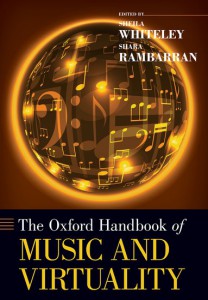The Oxford Handbook of Music and Virtuality
by Sheila Whiteley and Shara Rambarran


Average rating: ![]()
| 0 | rating | |
| 0 | rating | |
| 0 | rating | |
| 0 | rating |
Your rating: -
Book Presentation:
• A fully new look at the relationship between virtuality and music in a series of newly commissioned chapters
• Brings together a wide variety of scholars from different disciplines with a multitude of approaches
• Explores the possibilities and opportunities available to musicians in a new creative economy
• Explores the way that the intersection of the virtual and the real affects contemporary identities and communities
Has the virtual invaded the realm of the real, or has the real expanded its definition to include what once was characterized as virtual? With the continual evolution of digital technology, this distinction grows increasingly hazy. But perhaps the distinction has become obsolete; perhaps it is time to pay attention to the intersections, mutations, and transmigrations of the virtual and the real. Certainly it is time to reinterpret the practice and study of music. The Oxford Handbook of Music and Virtuality, edited by Sheila Whiteley and Shara Rambarran, is the first book to offer a kaleidoscope of interdisciplinary perspectives from scholars around the globe on the way in which virtuality mediates the dissemination, acquisition, performance, creation, and reimagining of music.
The Oxford Handbook of Music and Virtuality addresses eight themes that often overlap and interact with one another. Questions of the role of the audience, artistic agency, individual and communal identity, subjectivity, and spatiality repeatedly arise. Authors specifically explore phenomena including holographic musicians and virtual bands, and the benefits and detriments surrounding the free circulation of music on the internet. In addition, the book investigates the way in which fans and musicians negotiate gender identities as well as the dynamics of audience participation and community building in a virtual environment. The handbook rehistoricizes the virtual by tracing its progression from cartoons in the 1950s to current industry innovations and changes in practice. Well-grounded and wide-reaching, this is a book that students of any number of disciplines, from Music to Cultural Studies, have awaited.
About the authors:
Sheila Whiteley, Professor Emeritus, University of Salford, and Shara Rambarran, Assistant Professor, Queen's University The late Sheila Whiteley was Professor Emeritus (the University of Salford, UK) and a Research Fellow at the Bader International Study Centre, Queen's University, Ontario, Canada. She is author of Too Much Too Young: Popular Music, Age and Identity (2005). Shara Rambarran is an Assistant Professor of Music and Cultural Studies at the Bader International Study Centre, Queen's University, Canada. Shara gained her PhD in Music and Cultural Studies at the University of Salford.
Press Reviews:
"[The Oxford Handbook of] Music and Virtuality is a strong contribution to the literature on popular music and on computers and technology more broadly. Recommended." - Choice
See the publisher website: Oxford University Press
> On a related topic:
Haunted Soundtracks (2025)
Audiovisual Cultures of Memory, Landscape, and Sound
Dir. Kevin J. Donnelly and Aimee Mollaghan
Music for Superheroes (2025)
Film and Television Scores Since 1940
Music Films (2024)
Documentaries, Concert Films and Other Cinematic Representations of Popular Music
by Neil Fox
The Music of Space (2024)
Scoring the Cosmos in Film and Television